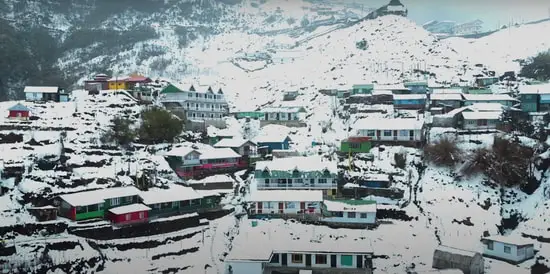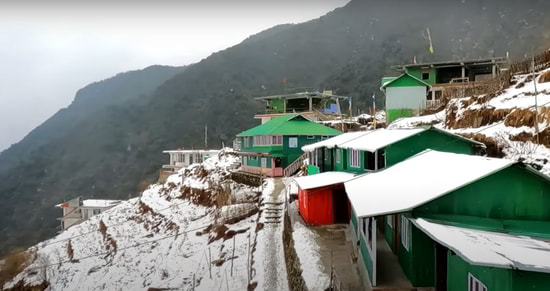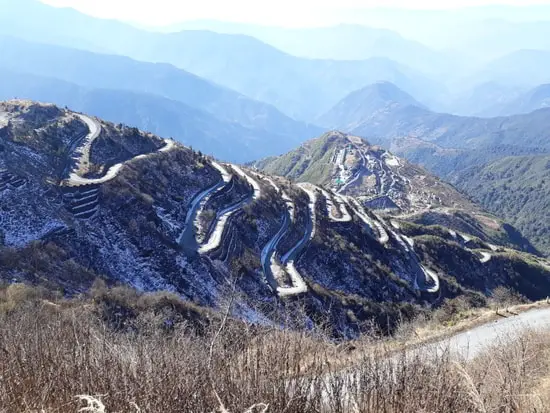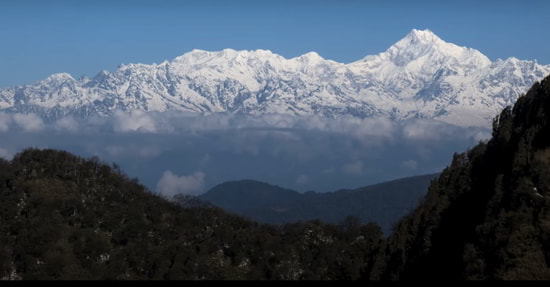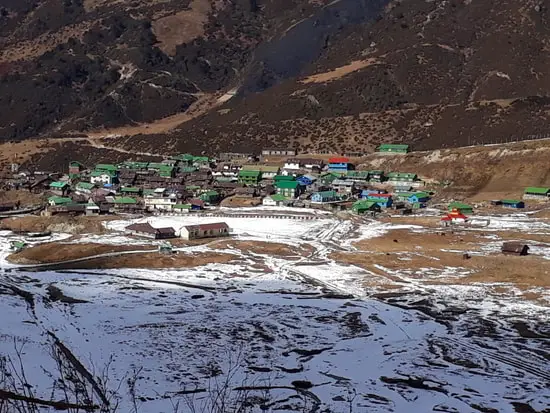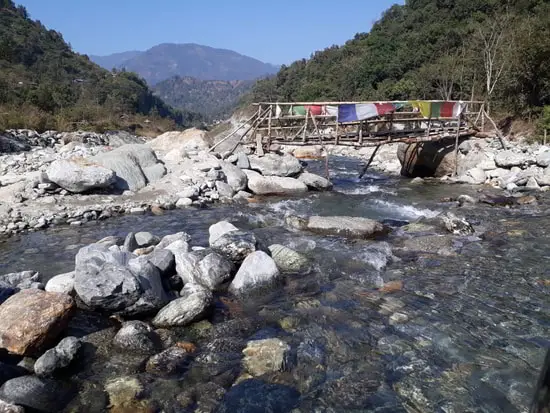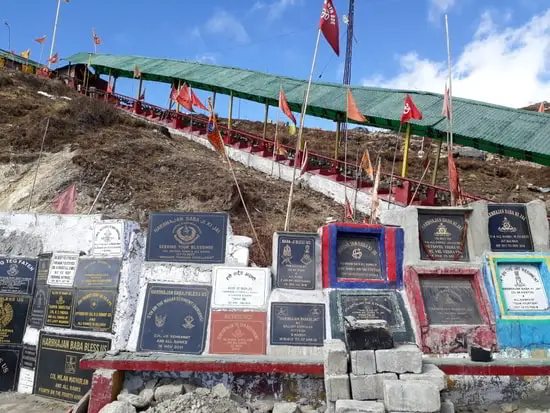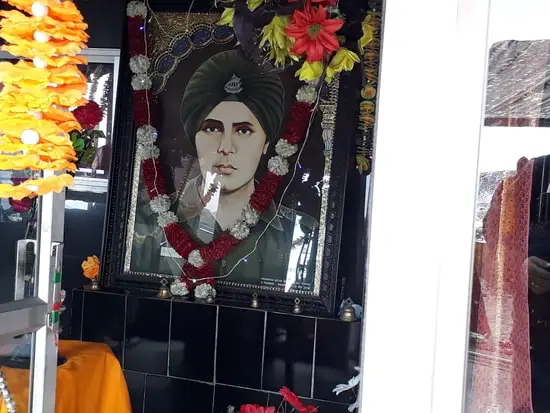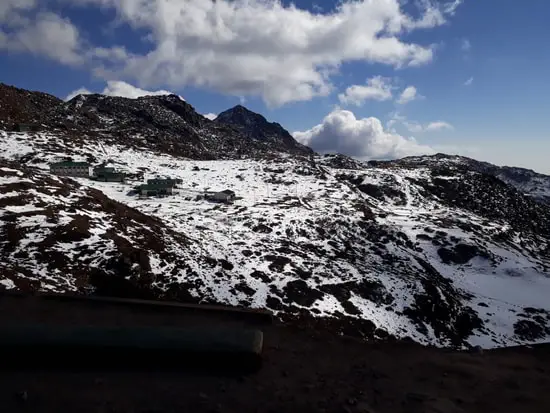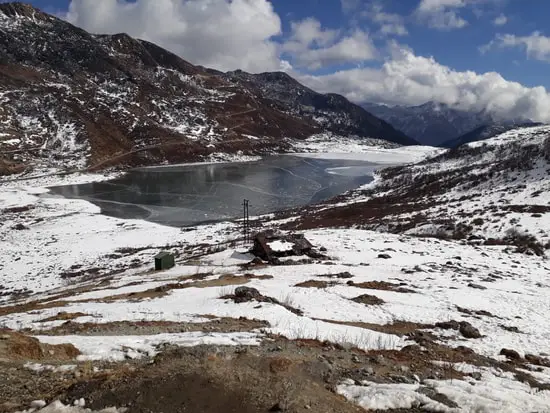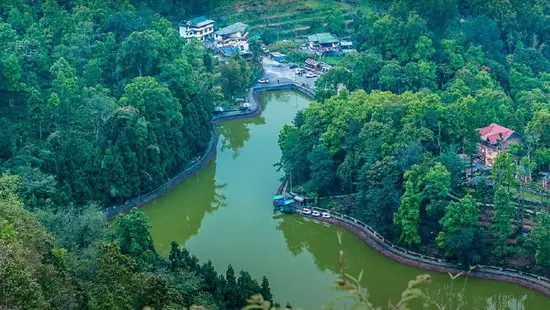A Guide to Zuluk & The Historic Silk Route
About Zuluk
Zuluk (also spelt as Dzuluk) is a tiny village settlement at an altitude of 10,100ft. It's located in lower Himalayas of Eastern Sikkim on the historic Old Silk Route which once connected India and Tibet.
On the Indian side, the Silk route starts from Pedong in Kalimpong district and goes through places like Rhenock, Rongli, Zuluk and northward to Nathang valley and Kupup.
And finally Jelepla Pass was used to reach the beautiful Chumbi valley of Tibbet and then the route would continue to Lhasa.
Till the first half of 20th century before the Chinese invaded Tibet, this old Silk Route was used heavily to trade silk, fur and wool between Tibet and India, and hence such name of the route.
But since 1962, Jelepla Pass has been closed. Now the official corridor between India and China in this area is Nathula Pass which is not far away.
Zuluk is only few kilometers away from the China border and has a base of Indian army. It's a small mountain hamlet with a population of about 700 most of who are Nepali. All these people had migrated to this place in search of better living as it lied on the Silk Route.
But now that the trade is gone, and the land is infertile for any farming, they mostly survive on construction of roadways.
But the nature has been liberal in blessing the place with huge tourism potential. The villagers have slowly started realizing that and extending their homes to tourists as home stays.
What to see in Zuluk
Zuluk is the transit point to visit so many other beautiful places around including all the points on the Silk Route. Zuluk by itself is only a small village with handful families. There is a small nag (king cobra) temple here with a cave like structure.
For views of Kanchenjunga snow peaks, lovely lakes, passes and other wonderful mountain landscapes, you need to take day trips from Zuluk and go further north towards Kupup.
There are 32 sharp hairpin bends (or zig zags) along the way which is an engineering marvel by itself. You can get the sight of this amazing zig zags on the mountain slopes from vantage points near Zuluk and also from the Thambi View Point.
Zuluk Zigzag
A great place for sunrise views over Kanchenjunga is Thambi Viewpoint which is about 14kms from Zuluk, at an altitude of 11,200ft and comes on the road to Lungthung (towards Kupup).
View of the peaks from Thambi as the sun rises is simply mind blowing. You can see amazing change of colors on the dazzling peaks as the sun rises from the opposite end. This nature's spectacle alone is good enough a reason to visit Zuluk.
View of Kanchenjunga from Thambi View Point
If you go further up to Lungthung (which is another 10kms away), you can actually get a better view of the entire range. This is considered the best sunrise viewpoint along the Silk Route (but you need to start earlier as it's further away from Zuluk).
Further up at an altitude of 13,500ft you reach the wonderful Nathang Valley. This is where the yak herders from Tibet used to graze their yaks when the Jelepla Pass was open.
This beautiful valley changes its colors in different seasons, turning to golden when the grasses dry up in autumn, to dazzling snowy white in the winter when it gets covered under thick snow, and to a blanket of colors when the flowers bloom in monsoon.
Nathang valley
You can see a long row of Buddhist prayer flags fluttering on top of a ridge here. There is also a monastery, a temple and several streams that flow through the valley.
There are several traditional and modern homestays that have come up in Nathang valley offering electricity, European style toilets, hot water, and fresh homemade food (both veggie & non-veg).
Stream Through Nathang Valley
Further up, you can take a short diversion and visit Old Baba Mandir (a temple built in the honor of an Indian soldier Baba Harbhajan who is worshipped as a deity). This is where the samadhi of Baba Harbhajan has been built on a bunker where he was posted while in Indian army.
Although he is dead, it is strongly believed by the army personnel here that his spirit is still around and guards the Indo China border. Chinese guards have also confirmed having seen a vigilant man at night on the border.
Steps to the Old Baba Mandir
The temple is located at an altitude of 14,600ft. Although the temple and the place of worship is on the roadside, it requires climbing of several steps to reach up to the bunker.
Reaching this original Baba Mandir is difficult for general tourists. Therefore a
New Baba Mandir has been built near Tsomgo Lake. The view of Nathang Valley from Old Baba Mandir is simply stunning.
Inside the Old Baba Mandir
Further along you will reach Kupup valley and the Kupup Lake at an altitude of 13,066ft. The Kupup lake has a shape of an elephant and therefore known also as Elephant Lake.
From Kupup lake, other than spectacular views of Kanchenjunga peaks, you also get lovely views of Tukla Valley and even Menmecho Lake.
Kupup Valley
As you drive along the road, you can get a glimpse of the wonderful Menmecho Lake, however you can not take your car up to the lake, there is no motorable route. There is a walking trail though (that starts near New Baba Mandir) which leads all the way to the lake.
Kupup Lake
Further ahead you will reach the barren Tukla Valley. World's highest altitude golf course known as Yak Golf Course (13,025ft) is further ahead and is also located in Kupup area. This 18-hole golf course is recorded in Guinness Book of World Records.
Soon after crossing Yak Golf Course, you can see the sight of Jelepla Pass which connects India with Lhasa of Tibet. The pass lies at an altitude of 14,000ft.
It is now closed following the Indo China war. 'La' in Tibetan means a pass, and the word 'Jelepla' means 'Beautiful Level Pass' - indeed this pass is a wonderful pass on a level land.
You can continue further along the road and even reach the New Baba Mandir, Tsomgo Lake provided you have the required permits (permit information is given below).
How to reach Zuluk & Silk Route
Firstly note that you will need a Sikkim registered vehicle in order to visit Zuluk and beyond. Vehicles from other states are not permitted along this route.
If you want to head to Zuluk directly from NJP railway station or Bagdogra airport, then the easiest route is to go up to Rangpo by taking National Highway 10. Rangpo is 80kms from NJP (84kms from Bagdogra) and takes about 2 hours 50 minutes drive.
The highway NH10 from Rangpo continues to Gangtok. However for Zuluk, you should take another route at Rangpo which passes through places such as Rorathang, Rhenock, Rongli Bazar, Lingtam, and leads all the way to Zuluk.
From Bagdogra or NJP the distance to Zuluk is about 150kms via Rangpo and takes about 5 and half hours drive.
You can also approach Zuluk from Kalimpong which is about 2 hours drive from NJP station or Bagdogra airport. From Kalimpong you can take the route via Algarah, Pedong, Reshikhola, Aritar and then to Rongli Bazaar.
Aritar Lake
At Rongli, it meets the previous route (58kms, takes about 2 & half hours drive) and then continues to Zuluk (another 1 & half hours drive).
If you are approaching Zuluk via Kalimpong, it would be a good idea to take an overnight break at
Kalimpong Town or at the picturesque mountain village further ahead known as
Sillery Gaon.
After Rongli Bazaar when you move towards Zuluk, you will come across a roadside waterfall known as Que Khola.
'Que' in Nepali means potato and khola means a stream. There used to be a large potato plantation in this area and the villagers used to wash their potatoes under the waterfall and hence the name. The 100-feet waterfall is worth a stop.
From Gangtok there is a route to Zuluk via Tsomgo Lake, New Baba Mandir, Kupup, Nathang Valley and then to Zuluk. It takes about 4 hours drive.
Actually from Gangtok area it is a single continuous route (Jawaharlal Nehru Road) that goes all the way up via Tsomgo Lake, Baba Mandir, Sarathang (where the approach-way to Nathula starts) etc to Kupup and then to Nathang valley, Zuluk etc.
So if you take a vehicle from Gangtok, you can go all the way to Zuluk or vice-versa.
Along the way you can also visit
Tsomgo Lake,
New Baba Mandir and
Nathula. A day trip is not advisable from either Gangtok or Kalimpong. You should plan to stay overnight at Zuluk if coming via Rangpo or Kalimpong, or at Nathang Valley if coming from Gangtok, and then visit the nearby places by car on a day trip.
Due to high altitude and low oxygen level, it is advisable that you acclimatize yourself on the first day to avoid breathing problems.
Permit for Zuluk
A separate Protected Area Permit is required for tourists visiting Zuluk and the Silk route (because it lies on the border area with China occupied Tibet). You need to carry passport size photos and photo ID proof (in original) to get your permit.
While approaching from Gangtok, you can get this permit from Sikkim Tourism Office at Gangtok. You can get it done through any registered local tour operator in Gangtok. You should hand-over the documents to the tour operator one day in advance.
NOTE: Foreigners are not allowed to visit Zuluk for border restrictions.
While approaching Zuluk from Rangpo or Kalimpong, you can get the permit along the way at Rongli Bazaar at the SDPO Office (open till 2pm on weekdays, 11am on Saturdays, closed on Sundays). Ronlgi is 35kms from Rangpo.
Your driver can help with the process. It usually takes about 30 minutes to get the permit, sometimes less. You should take a large vehicle like a Scorpio or a Jeep.
At Rongli, you can get your permits for Zuluk and Tsomgo Lake (but not for Nathula Pass). You must carry ID Proof such as Passport / Voter ID, etc and two passport size photos for the permit (PAN card is not accepted).
For minors, you should carry the birth certificate or passport (father's Voter ID Card will also do). Permit charges at Rongli for a group of 2 to 3 persons would be around Rs. 200.
Where to stay in Zuluk
There are no proper hotels in Zuluk or for that matter in the entire upper reaches of the Silk Route. Several basic homestays have come up that are run by the villagers.
They offer comfortable rooms with electricity, attached toilet of European style, homemade food and lots of warm blankets.
People here are not only simple, they are also very friendly and helpful. Other than Indian vegetarian dishes, they also make chicken, eggs and noodles.
A nice homestay in Zuluk is Snow Lion owned by Chundu Bhutia. Although the homestay looks quite simple and basic from outside, the rooms are clean and cozy. And most importantly the rooms have western style attached baths and fitted with geysers... a rarity in this part of the hills.
Some of the other homestays here include:
Yanchen Homestay: A budget-friendly homestay with great views.
Zuluk Mama Homestay: Offers cozy rooms and good hospitality at a mid-range price.
Dew Drop Homestay: Has standard amenities and beautiful mountain vistas.
Zuluk Dil Maya Homestay: A popular budget-friendly option.
Hill Homestay Zuluk: Provides a local experience with good views.
If you are returning from Zuluk to Kalimpong, you can also plan to spend a night at Aritar and enjoy the beautiful manmade lake surrounded by trees. You can also stay at Makhim nearby. There are nice homestays at these places with basic facilities.
Best time to visit
There are two great seasons to visit Zuluk... April to June, and then again from September to November... this is when the temperature remains relatively mild. The entire place gets covered with colorful wildflowers, the sky remains clear and views of the mountains are wonderful. The average temperature during this period ranges from 10°C to 20°C.
Zuluk experiences an extremely cold climate in winter. From December onwards it starts snowing and from January onwards the roads often get blocked due to heavy snow. Temperature becomes sub-zero. And it remains under snow usually till March-end.
July to early-September is the monsoon time when you won't get much views due to fog and cloud. This is also the time prone to landslides.
Related Articles
|
Visitors' Reviews/Comments
Nisha Karia (November 2024)
Dear Raj, You have answered all my queries!!! Thank you and bless you for all the good work. We are planning to go to Zuluk in March. Is it possible? We are from Mumbai. Is the cold bearable in March? Should we do Darjeeling first or should we start from Kalimpong to Zuluk and end with the Gangtoki Darjeeling - Ghoom trip? 13 nights program. 8 or 9th March in Zuluk is okay? Or will it be snow covered. We have already seen lots of snow is Kashmir in March.
Raj (darjeeling-tourism.com) November 2024
Hello Nisha, starting with Kalimpong and Zuluk is a good plan under normal circumstances. However, Zuluk often remains snow-covered in early March, and sometimes the road gets blocked due to heavy snow. So, I would suggest that you keep your Zuluk visit towards the end of your trip to give yourself a better chance of visiting the place. And by that time you would get somewhat used to the cold as well. Yes, it could be very cold up there, particularly at night and early morning.
Zakir Husain (June 2024)
Dear Mr. Raj, thank you for your very informative website. We were planning to visit Nathung Valley in last week of October. Our planned programme is:
Saturday: Arrive at NJP via Darjeeling Mail and transfer to Gangtok
Sunday: Tsongo Lake, Baba Madir, Nathula Pass, Elephant Lake, Nathung Valley and stay at Zuluk
Monday: Proceed to Aritrar and then NJP (with stoppages at Sillary gaon and Mairon gaon/Samalbong).
My questions are:
[1] Is the Sunday plan do able? Or will it be wiser to stay at Nathung? I believe that Zuluk offers slightly better accommodation and will be less cold.
[2] Is going straight to Nathung valley on second day advisable in view of altitude? Or should we halt at Gangtok for an extra night. We have visited Gangtok several times and so would like to avoid staying here for 2 nights.
Raj (darjeeling-tourism.com) June 2024
Hello, your Sunday plan is doable. The total circuit from Gangtok to Zuluk should take around 4 hours (in normal traffic conditions) plus the time you spend at each spot. So, try to time your journey correctly.
Staying one night at Gangtok is okay, a second night won't help further in acclimatization. Secondly, Nathang Valley is at a lower altitude than Nathula and you will be getting to Nathula before Nathang. So, try to climb the stairs at Nathula very slowly and with breaks. Once you are done with Nathula, the rest should not be an issue.
Dr Mohd Sohail Sheikh (March 2024)
Hi Dear Raj sir, Glad to see your knowledgeable and true replies to everyone. May God bless you. I am planning to visit Sikkim on 2 nd may 2024 with two couples and two children of age 6 years... will reach NJP station between 6-9AM..then move to reach and stay at Zuluk... then next day early in morning around 5-6AM will move to Nathula by enroute sightseeing.
As you informed earlier, we can't get permit for Nathula at Rongli, then can we arrange permit through travel agency through which we are doing all tour package... can they send that permit with the driver who is coming to pick up us at NJP... kindly guide what to do if we want to visit Nathula pass on the way from Zuluk to Gangtok???
Raj (darjeeling-tourism.com) March 2024
Hello, yes you can ask your tour operator to pre-arrange the Nathula permit from Gangtok and send it across. You will need to send scanned copies of your photos and ID cards in advance.
Soumen Paul (February 2023)
Hi, It's a great pleasure to read your mesmerizing travelogues and perceive the joy hidden in mountains. I am planning to visit Darjeeling from Kolkata via Rishop, Zuluk, Gangtok and Pelling in the end of coming March.
Will it be possible to reach Zuluk from Rishop via NH-717 for a night stay at Zuluk so that Chhangu lake and Baba Mandir can be visited on the next day before reaching Gangtok? Can the permit for Chhangu lake and Baba Mandir be arranged from Zuluk?
Raj (darjeeling-tourism.com) February 2023
You can get to Zuluk from Rishop via NH-717A. You will need to take your permits at Rongli Bazaar check post. However, note that they allow only Sikkim-registered vehicles beyond Rongli.
You can not take a non-Sikkim vehicle there unless you are driving your own private car (an SUV) which must have high ground clearance.
At Rongli, you can also get permits for Baba Mandir and Tsomgo Lake (but not Nathula), and complete the full circuit through Nathang Valley and Kupup, end exit through Gangtok.
Subhendu Roy (February 2023)
Hi Raj, We are a family of 2 adults and one 3 year old child traveling from Kolkata and our desired Sikkim itinerary for May, 2023 is given below.
Day 1: NJP to Zuluk
Day 2: Visit Zuluk prime attractions
Day 3: Zuluk to Gangtok transfer via visiting Tsomgo Lake, Baba Mandir
Day 4: Visit Ravangla Buddha park and transfer to Namchi
Day 5: Namchi to NJP for return journey
However, we are not sure about visiting Zuluk and Tsomgo Lake with a 3 year old child in May. Could you please let us know your suggestions in this regard?
Or Do you think we should visit Gangtok first and then plan the rest of the above trip considering we have a 3 year old child with us?
If yes, will it be safe to travel by Vande BHARAT express (arrival time at NJP: 1:25 pm) train from Kolkata to reach Gangtok?
Thank you very much for your valuable suggestions. Keep it up. All the best.
Raj (darjeeling-tourism.com) February 2023
Hi, Firstly note that in order to visit Zuluk, you will need a Sikkim-registered vehicle, non-Sikkim commercial vehicles are not allowed on that route.
It will be difficult to arrange for a Sikkim-registered vehicle at NJP for that route, so starting the trip from Gangtok will be logistically easier.
However, Tsomgo Lake being at an altitude higher than 12,000ft and Zuluk nearly 10,000ft, it is not at all recommended to visit such high altitude places with a 3-year old infant.
In fact, for Tsomgo, permits are not issued to children below 5 years of age. Plus, your timeline is too short to cover that circuit.
The second part of your plan (day-4) is also quite hectic. You need to ideally rework your itinerary and make it more relaxed rather than simply rushing from one place to the other.
Nilesh Kosambi (December 2020)
I traveled to Zuluk by my own car from Gujarat state last December 2019. I got permit from Rongli Bazaar. Every Indian can get permit but the owner himself should drive his private car, means anyother person cannot get permit driving with my car. They check driving license and RC book details.
Dipak Sarkar (January 2020)
Hi, planning a tour of Silk route + Baba Mandir + Nathula + Tsomgo Lake. Will first week of April be fine to start? Can I get all necessary permissions if I proceed from NJP-Kalimpong for entire route? Thanks in anticipation.
Raj (darjeeling-tourism.com) January 2020
April is a good time to visit the Silk Route. Permits are issued at Rongli, however, you can not get permit for Nathula Pass from Rongli. You can visit Baba Mandir and Tsomgo Lake though. Also note that you need a Sikkim registered car. Local cars/taxis from NJP or Kalimpong are not allowed on that route.
Mohit (August 2018)
Hi, Thanks a lot for your useful articles. We plan to travel to Zuluk from Bagdogra (3 Indian Boys) by hiring a rental car from Zoomcar. Please suggest if any issue in taking this car upto Zuluk. Also confirm if any extra permit is required to take car other than PAP.
Raj (darjeeling-tourism.com) August 2018
Hi, Zoomcars or any self-driven rental cars are not allowed in any protected areas of Sikkim including in Zuluk.
Catherine Bond (January 2017)
Hi Raj, Thank you so much for all your helpful advice! My husband and I are planning a trip to Darjeeling and Sikkim in April 2017 and I'm struggling to find info on Sikkim. We are from South Africa and from what I can tell we are limited by where we can travel to in Sikkim.
We'd love to travel the Sikkim Silk Route but I can't seem to find out if this would be possible as a foreigner? Are you able to provide some advice? Also, would you recommend that we organise a tour through a recommend travel operator in Sikkim? I hope to hear from you! Kind regards.
Raj (darjeeling-tourism.com) January 2017
Hi, Silk Route can be approached either via Rangpo, Pedong (Kalimpong), or Gangtok/Nathula. Foreigners are unfortunately not allowed on that route being close to Tibet/China border. Yes, you should organize your tours in Sikkim through a Sikkim govt. registered tour operator.
T.M. Nathan (October 2016)
Dear Mr.Raj, I am a Malaysian and am travelling with a group of 20 friends, most of whom are Seniors ( 60+). I would like to visit Zuluk as part of my 9 day tour of Kolkata, Gangtok, Kalimpong & Darjeeling. As we would like very much to experience snowfall, I included Zuluk in my itinerary. I have been informed that being foreigners, we will not be allowed to gain access to Zuluk even with the Restricted Area Permit (RAP) or Inner Line Permit (ILP). Is this true?
We are due to travel between 18th Feb 2017 till 27th Feb 2017. I feel that the journey is not worth it without a visit to Zuluk. Please advise as I am being given conflicting views on Zuluk. Another point of clarification - Are the dates chosen in Feb 2017 ideal without much fog?
Raj (darjeeling-tourism.com) October 2016
Hello, Zuluk requires a special permit and not the usual Restricted Area Permit (interchangeably called Inner Line Permit). Being part of east Sikkim and close to the border of Tibet (which is part of China), foreigners are not given permission to visit Zuluk just like Nathula Pass. In any case around February the route to Zuluk is likely to be closed due to heavy snow. February is otherwise okay for other places (will be very cold though), there could be fog at times but you should also get enough clear sky.
|
